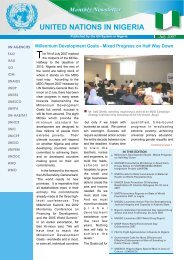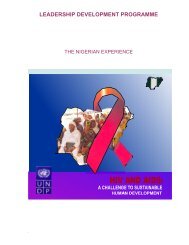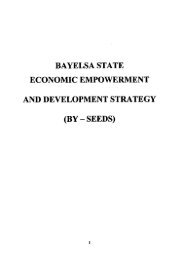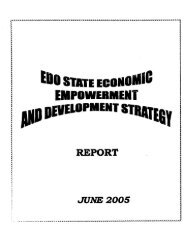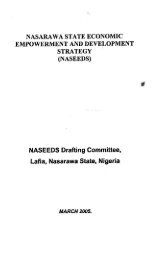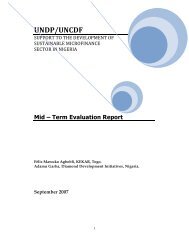Niger Delta Human Development Report - UNDP Nigeria - United ...
Niger Delta Human Development Report - UNDP Nigeria - United ...
Niger Delta Human Development Report - UNDP Nigeria - United ...
You also want an ePaper? Increase the reach of your titles
YUMPU automatically turns print PDFs into web optimized ePapers that Google loves.
Box 6.1: Sustainable Livelihoods<br />
Sustainable livelihoods must be accompanied by industrial diversification and economic growth, and grounded in<br />
several capital assets fundamental to the development of communities. These include:<br />
• Natural capital: Natural resource stocks from which resource flows useful for livelihoods are derived (land,<br />
water, wildlife, biodiversity, environmental resources, etc.)<br />
• <strong>Human</strong> capital: The skills, knowledge, ability to labour and good health important to pursuing different<br />
livelihood strategies.<br />
• Physical capital: The basic infrastructures (transport, shelter, water, energy and communities), and the<br />
production equipment and means that enable people to pursue livelihoods<br />
• Social capital: The social resources (networks, membership groups, relationships of trust, access to wider<br />
institutions of society) upon which people draw in pursuit of livelihoods<br />
• Financial capital: The financial resources (whether savings, supplies of credit or regular remittances or<br />
pensions) that supply people with different livelihood options.<br />
Source: Carney 1998; Scoones 1998.<br />
The lack of work<br />
correlates to the highest<br />
incidences of youth<br />
restiveness and conflicts.<br />
The discovery of<br />
petroleum shifted<br />
attention from<br />
agricultural and rural<br />
transformation to urban<br />
industrialization and<br />
the extraction of<br />
petroleum resources with<br />
serious repercussions for<br />
livelihoods<br />
rural transformation. Substantial resources<br />
poured into agricultural facilities, basic<br />
education and primary health care. This<br />
was the period when agricultural settlement<br />
was established in many parts of <strong>Niger</strong>ia.<br />
The Western Region served as the<br />
benchmark for free education, agricultural<br />
settlements, industrial development and the<br />
promotion of small-scale industries, among<br />
other things. Regional advantages were<br />
given serious consideration, so groundnuts<br />
were cultivated in the north, cocoa in the<br />
west, and rubber and palm oil in the east.<br />
The discovery of large stores of petroleum<br />
shifted attention to urban industrialization<br />
and the extraction of these resources.<br />
People were pulled from rural areas to<br />
urban centres, which widened gaps between<br />
the two. Agricultural productivity<br />
plummeted, while urban areas began<br />
suffering from strains on infrastructure,<br />
unemployment and a proliferation of<br />
social vices. The Government’s inability to<br />
promote balanced development during the<br />
oil boom has had serious repercussions for<br />
livelihoods.<br />
Sustainable livelihoods require people to<br />
have access to economic activities,<br />
especially employment. The link between<br />
employment and sustainable livelihoods<br />
derives from the second aspect of human<br />
development, which emphasizes the use<br />
people are able to make of their acquired<br />
capabilities for employment, productive<br />
activities or leisure. In the <strong>Niger</strong> <strong>Delta</strong>,<br />
available data show that formal and<br />
informal sector activities are generally at a<br />
low level, meaning that access to<br />
employment and other economic activities<br />
is limited (table 6.1).<br />
Except for Abia, Edo and Ondo states, the<br />
unemployment rate is much higher in the<br />
region than the national average. 1 Similarly,<br />
the underemployment rate is generally<br />
higher, except in Edo, Bayelsa and Abia<br />
states. A particularly disturbing dimension<br />
is the incidence of unemployment per<br />
household. For example, 5.8 per cent of<br />
households have one to two dependents<br />
without a job, 15.3 per cent have three to<br />
four dependents without a job, and 72.5<br />
per cent have five or more dependents<br />
without a job (DPC, 2001). A high level<br />
of unemployment increases the<br />
dependency ratio, which worsens poverty.<br />
Data from the NDDC (2005) portray the<br />
same pattern of findings on<br />
unemployment. The lack of work, as a<br />
good direct measurement of<br />
unemployment, has been most markedly<br />
pronounced in <strong>Delta</strong>, Rivers and Bayelsa<br />
states, which also have the highest incidence<br />
1 The figures for Edo State in the table cannot be realistically interpreted as a reflection of the rate of unemployment. For example,<br />
a survey from the Federal Office of Statistics that defined the labour force age bracket as 15-70 years (rather than the 15-64 years used<br />
by the International Labour Organization) reports a composite unemployment rate of 14.3 per cent, an urban rate of 24 per cent and<br />
a rural of 11.8 per cent for Edo State. For Cross River State, the figures are 16.6 per cent, 7.3 per cent and 18.3 per cent, respectively.<br />
130 NIGER DELTA HUMAN DEVELOPMENT REPORT



